Accounting Information System Report: MEGA Mart Smart Trolley
VerifiedAdded on 2022/10/19
|13
|3135
|17
Report
AI Summary
This report examines the implementation of smart shopping trolleys in a retail setting, specifically focusing on a case study of MEGA Mart. The report begins with a literature review, exploring the features and advantages of smart trolleys, including RFID technology, smart shelves, and indoor navigation. It then presents a detailed cost-benefit analysis, evaluating the financial implications of introducing smart trolleys, including both one-time and recurring costs, along with the net present value and break-even analysis. The report also outlines organizational strategies for implementing LCD trolley checkouts and self-checkout systems. A system flowchart is included to illustrate the process flow of the smart shopping system. The report concludes by summarizing the benefits of smart trolleys, such as improved customer convenience, reduced wait times, and enhanced shopping experiences, while also acknowledging the disadvantages and providing a clear comparison between traditional and smart checkout systems. The report is a comprehensive analysis of the accounting information system for smart trolleys.
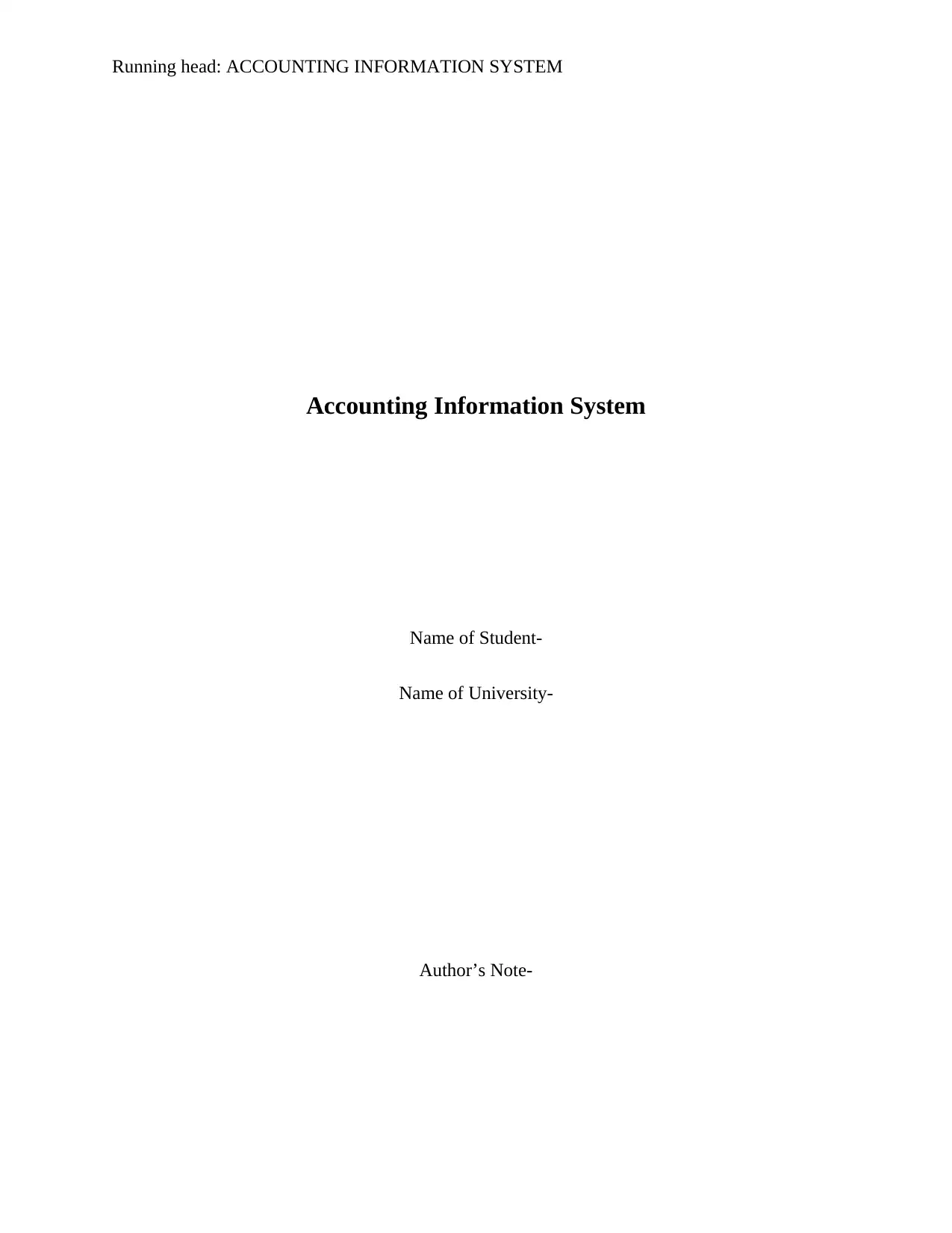
Running head: ACCOUNTING INFORMATION SYSTEM
Accounting Information System
Name of Student-
Name of University-
Author’s Note-
Accounting Information System
Name of Student-
Name of University-
Author’s Note-
Paraphrase This Document
Need a fresh take? Get an instant paraphrase of this document with our AI Paraphraser
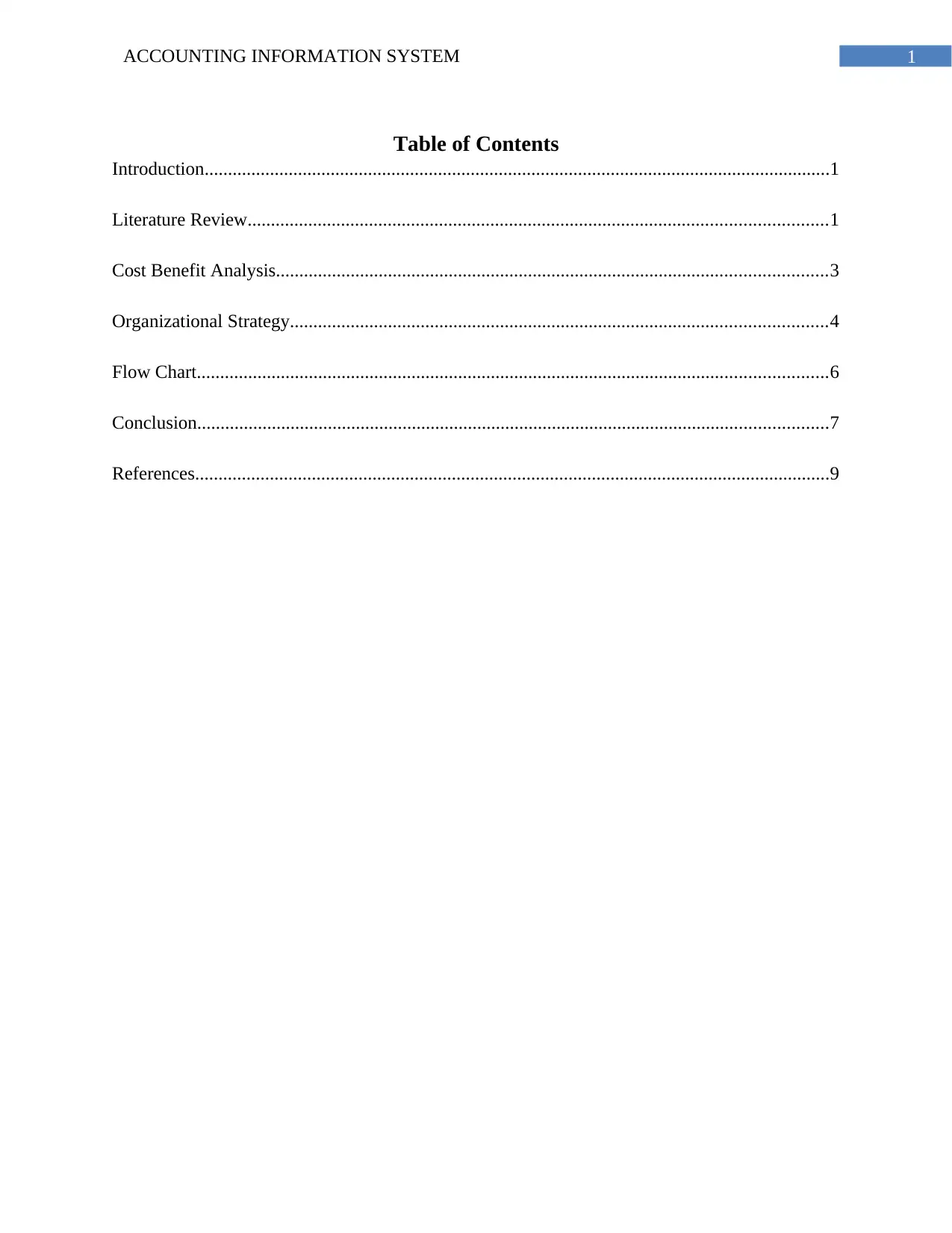
1ACCOUNTING INFORMATION SYSTEM
Table of Contents
Introduction......................................................................................................................................1
Literature Review............................................................................................................................1
Cost Benefit Analysis......................................................................................................................3
Organizational Strategy...................................................................................................................4
Flow Chart.......................................................................................................................................6
Conclusion.......................................................................................................................................7
References........................................................................................................................................9
Table of Contents
Introduction......................................................................................................................................1
Literature Review............................................................................................................................1
Cost Benefit Analysis......................................................................................................................3
Organizational Strategy...................................................................................................................4
Flow Chart.......................................................................................................................................6
Conclusion.......................................................................................................................................7
References........................................................................................................................................9
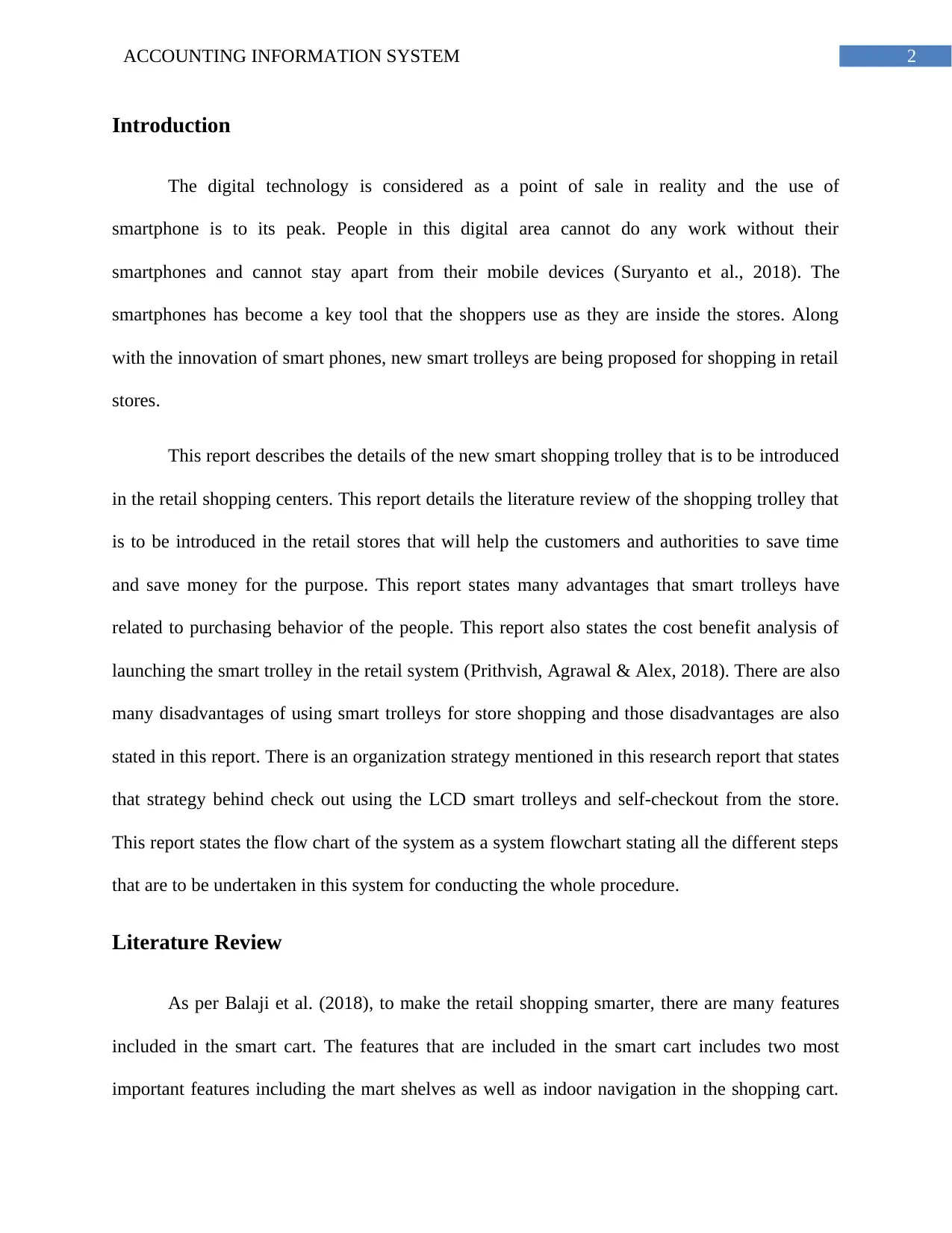
2ACCOUNTING INFORMATION SYSTEM
Introduction
The digital technology is considered as a point of sale in reality and the use of
smartphone is to its peak. People in this digital area cannot do any work without their
smartphones and cannot stay apart from their mobile devices (Suryanto et al., 2018). The
smartphones has become a key tool that the shoppers use as they are inside the stores. Along
with the innovation of smart phones, new smart trolleys are being proposed for shopping in retail
stores.
This report describes the details of the new smart shopping trolley that is to be introduced
in the retail shopping centers. This report details the literature review of the shopping trolley that
is to be introduced in the retail stores that will help the customers and authorities to save time
and save money for the purpose. This report states many advantages that smart trolleys have
related to purchasing behavior of the people. This report also states the cost benefit analysis of
launching the smart trolley in the retail system (Prithvish, Agrawal & Alex, 2018). There are also
many disadvantages of using smart trolleys for store shopping and those disadvantages are also
stated in this report. There is an organization strategy mentioned in this research report that states
that strategy behind check out using the LCD smart trolleys and self-checkout from the store.
This report states the flow chart of the system as a system flowchart stating all the different steps
that are to be undertaken in this system for conducting the whole procedure.
Literature Review
As per Balaji et al. (2018), to make the retail shopping smarter, there are many features
included in the smart cart. The features that are included in the smart cart includes two most
important features including the mart shelves as well as indoor navigation in the shopping cart.
Introduction
The digital technology is considered as a point of sale in reality and the use of
smartphone is to its peak. People in this digital area cannot do any work without their
smartphones and cannot stay apart from their mobile devices (Suryanto et al., 2018). The
smartphones has become a key tool that the shoppers use as they are inside the stores. Along
with the innovation of smart phones, new smart trolleys are being proposed for shopping in retail
stores.
This report describes the details of the new smart shopping trolley that is to be introduced
in the retail shopping centers. This report details the literature review of the shopping trolley that
is to be introduced in the retail stores that will help the customers and authorities to save time
and save money for the purpose. This report states many advantages that smart trolleys have
related to purchasing behavior of the people. This report also states the cost benefit analysis of
launching the smart trolley in the retail system (Prithvish, Agrawal & Alex, 2018). There are also
many disadvantages of using smart trolleys for store shopping and those disadvantages are also
stated in this report. There is an organization strategy mentioned in this research report that states
that strategy behind check out using the LCD smart trolleys and self-checkout from the store.
This report states the flow chart of the system as a system flowchart stating all the different steps
that are to be undertaken in this system for conducting the whole procedure.
Literature Review
As per Balaji et al. (2018), to make the retail shopping smarter, there are many features
included in the smart cart. The features that are included in the smart cart includes two most
important features including the mart shelves as well as indoor navigation in the shopping cart.
⊘ This is a preview!⊘
Do you want full access?
Subscribe today to unlock all pages.

Trusted by 1+ million students worldwide
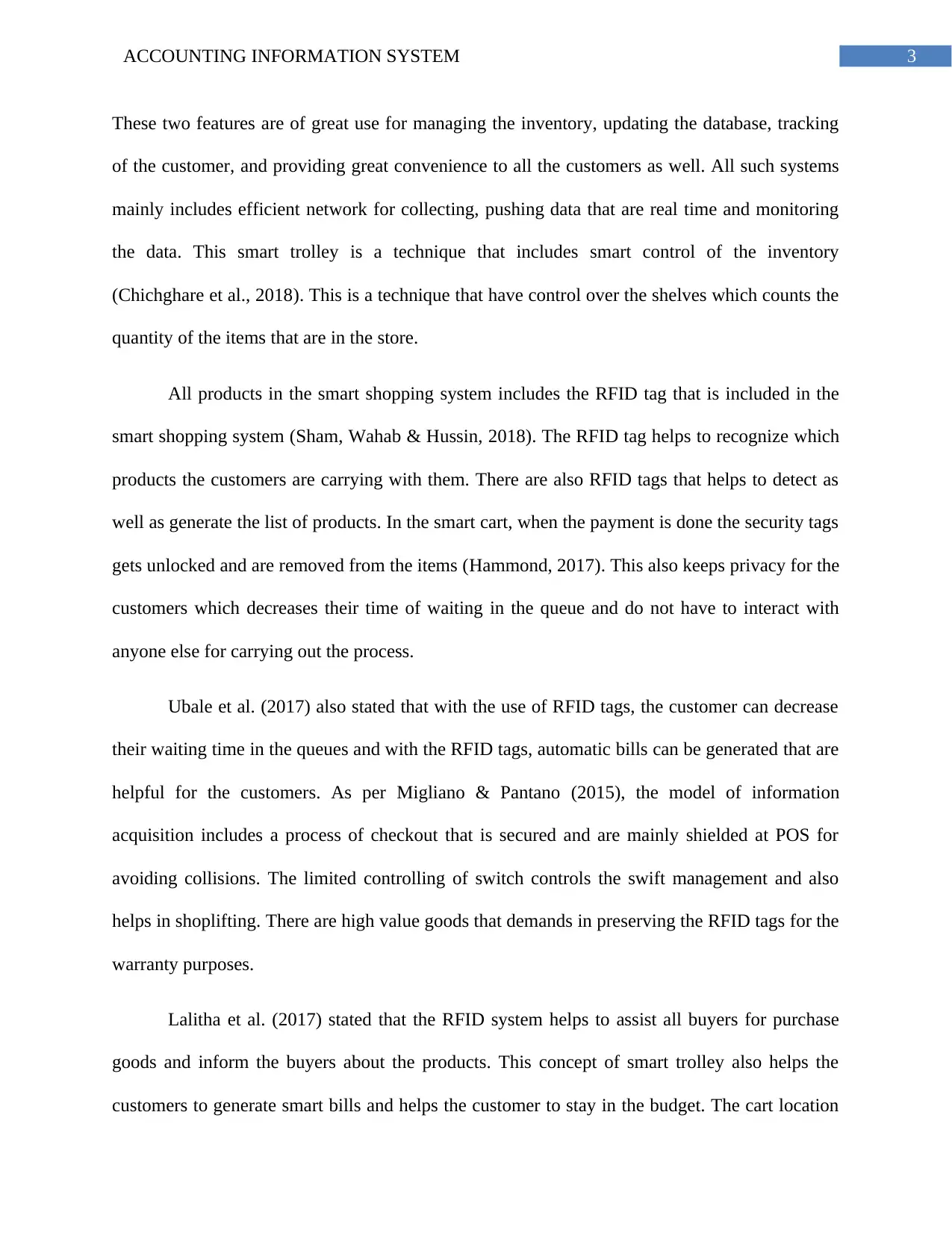
3ACCOUNTING INFORMATION SYSTEM
These two features are of great use for managing the inventory, updating the database, tracking
of the customer, and providing great convenience to all the customers as well. All such systems
mainly includes efficient network for collecting, pushing data that are real time and monitoring
the data. This smart trolley is a technique that includes smart control of the inventory
(Chichghare et al., 2018). This is a technique that have control over the shelves which counts the
quantity of the items that are in the store.
All products in the smart shopping system includes the RFID tag that is included in the
smart shopping system (Sham, Wahab & Hussin, 2018). The RFID tag helps to recognize which
products the customers are carrying with them. There are also RFID tags that helps to detect as
well as generate the list of products. In the smart cart, when the payment is done the security tags
gets unlocked and are removed from the items (Hammond, 2017). This also keeps privacy for the
customers which decreases their time of waiting in the queue and do not have to interact with
anyone else for carrying out the process.
Ubale et al. (2017) also stated that with the use of RFID tags, the customer can decrease
their waiting time in the queues and with the RFID tags, automatic bills can be generated that are
helpful for the customers. As per Migliano & Pantano (2015), the model of information
acquisition includes a process of checkout that is secured and are mainly shielded at POS for
avoiding collisions. The limited controlling of switch controls the swift management and also
helps in shoplifting. There are high value goods that demands in preserving the RFID tags for the
warranty purposes.
Lalitha et al. (2017) stated that the RFID system helps to assist all buyers for purchase
goods and inform the buyers about the products. This concept of smart trolley also helps the
customers to generate smart bills and helps the customer to stay in the budget. The cart location
These two features are of great use for managing the inventory, updating the database, tracking
of the customer, and providing great convenience to all the customers as well. All such systems
mainly includes efficient network for collecting, pushing data that are real time and monitoring
the data. This smart trolley is a technique that includes smart control of the inventory
(Chichghare et al., 2018). This is a technique that have control over the shelves which counts the
quantity of the items that are in the store.
All products in the smart shopping system includes the RFID tag that is included in the
smart shopping system (Sham, Wahab & Hussin, 2018). The RFID tag helps to recognize which
products the customers are carrying with them. There are also RFID tags that helps to detect as
well as generate the list of products. In the smart cart, when the payment is done the security tags
gets unlocked and are removed from the items (Hammond, 2017). This also keeps privacy for the
customers which decreases their time of waiting in the queue and do not have to interact with
anyone else for carrying out the process.
Ubale et al. (2017) also stated that with the use of RFID tags, the customer can decrease
their waiting time in the queues and with the RFID tags, automatic bills can be generated that are
helpful for the customers. As per Migliano & Pantano (2015), the model of information
acquisition includes a process of checkout that is secured and are mainly shielded at POS for
avoiding collisions. The limited controlling of switch controls the swift management and also
helps in shoplifting. There are high value goods that demands in preserving the RFID tags for the
warranty purposes.
Lalitha et al. (2017) stated that the RFID system helps to assist all buyers for purchase
goods and inform the buyers about the products. This concept of smart trolley also helps the
customers to generate smart bills and helps the customer to stay in the budget. The cart location
Paraphrase This Document
Need a fresh take? Get an instant paraphrase of this document with our AI Paraphraser
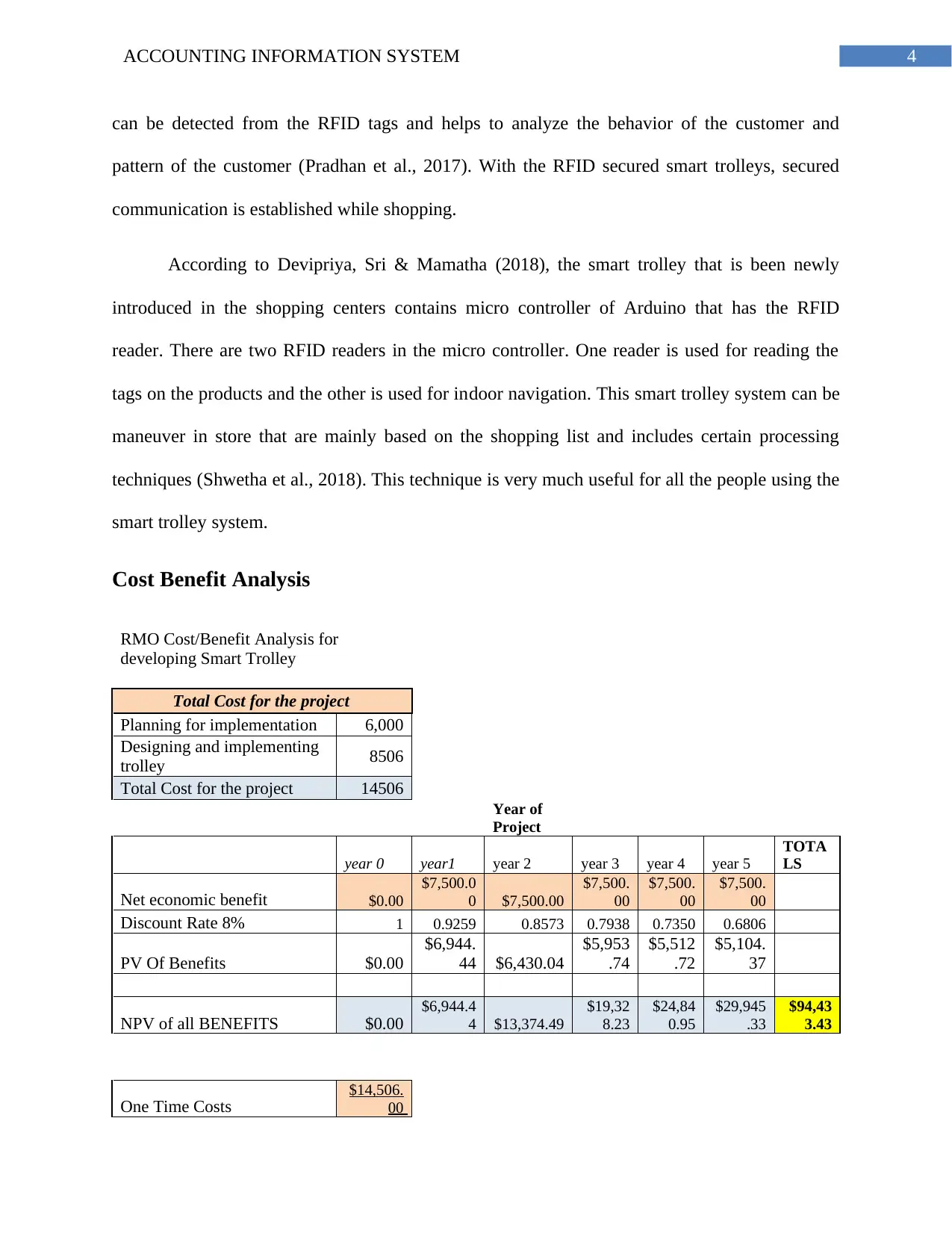
4ACCOUNTING INFORMATION SYSTEM
can be detected from the RFID tags and helps to analyze the behavior of the customer and
pattern of the customer (Pradhan et al., 2017). With the RFID secured smart trolleys, secured
communication is established while shopping.
According to Devipriya, Sri & Mamatha (2018), the smart trolley that is been newly
introduced in the shopping centers contains micro controller of Arduino that has the RFID
reader. There are two RFID readers in the micro controller. One reader is used for reading the
tags on the products and the other is used for indoor navigation. This smart trolley system can be
maneuver in store that are mainly based on the shopping list and includes certain processing
techniques (Shwetha et al., 2018). This technique is very much useful for all the people using the
smart trolley system.
Cost Benefit Analysis
RMO Cost/Benefit Analysis for
developing Smart Trolley
Total Cost for the project
Planning for implementation 6,000
Designing and implementing
trolley 8506
Total Cost for the project 14506
Year of
Project
year 0 year1 year 2 year 3 year 4 year 5
TOTA
LS
Net economic benefit $0.00
$7,500.0
0 $7,500.00
$7,500.
00
$7,500.
00
$7,500.
00
Discount Rate 8% 1 0.9259 0.8573 0.7938 0.7350 0.6806
PV Of Benefits $0.00
$6,944.
44 $6,430.04
$5,953
.74
$5,512
.72
$5,104.
37
NPV of all BENEFITS $0.00
$6,944.4
4 $13,374.49
$19,32
8.23
$24,84
0.95
$29,945
.33
$94,43
3.43
One Time Costs
$14,506.
00
can be detected from the RFID tags and helps to analyze the behavior of the customer and
pattern of the customer (Pradhan et al., 2017). With the RFID secured smart trolleys, secured
communication is established while shopping.
According to Devipriya, Sri & Mamatha (2018), the smart trolley that is been newly
introduced in the shopping centers contains micro controller of Arduino that has the RFID
reader. There are two RFID readers in the micro controller. One reader is used for reading the
tags on the products and the other is used for indoor navigation. This smart trolley system can be
maneuver in store that are mainly based on the shopping list and includes certain processing
techniques (Shwetha et al., 2018). This technique is very much useful for all the people using the
smart trolley system.
Cost Benefit Analysis
RMO Cost/Benefit Analysis for
developing Smart Trolley
Total Cost for the project
Planning for implementation 6,000
Designing and implementing
trolley 8506
Total Cost for the project 14506
Year of
Project
year 0 year1 year 2 year 3 year 4 year 5
TOTA
LS
Net economic benefit $0.00
$7,500.0
0 $7,500.00
$7,500.
00
$7,500.
00
$7,500.
00
Discount Rate 8% 1 0.9259 0.8573 0.7938 0.7350 0.6806
PV Of Benefits $0.00
$6,944.
44 $6,430.04
$5,953
.74
$5,512
.72
$5,104.
37
NPV of all BENEFITS $0.00
$6,944.4
4 $13,374.49
$19,32
8.23
$24,84
0.95
$29,945
.33
$94,43
3.43
One Time Costs
$14,506.
00
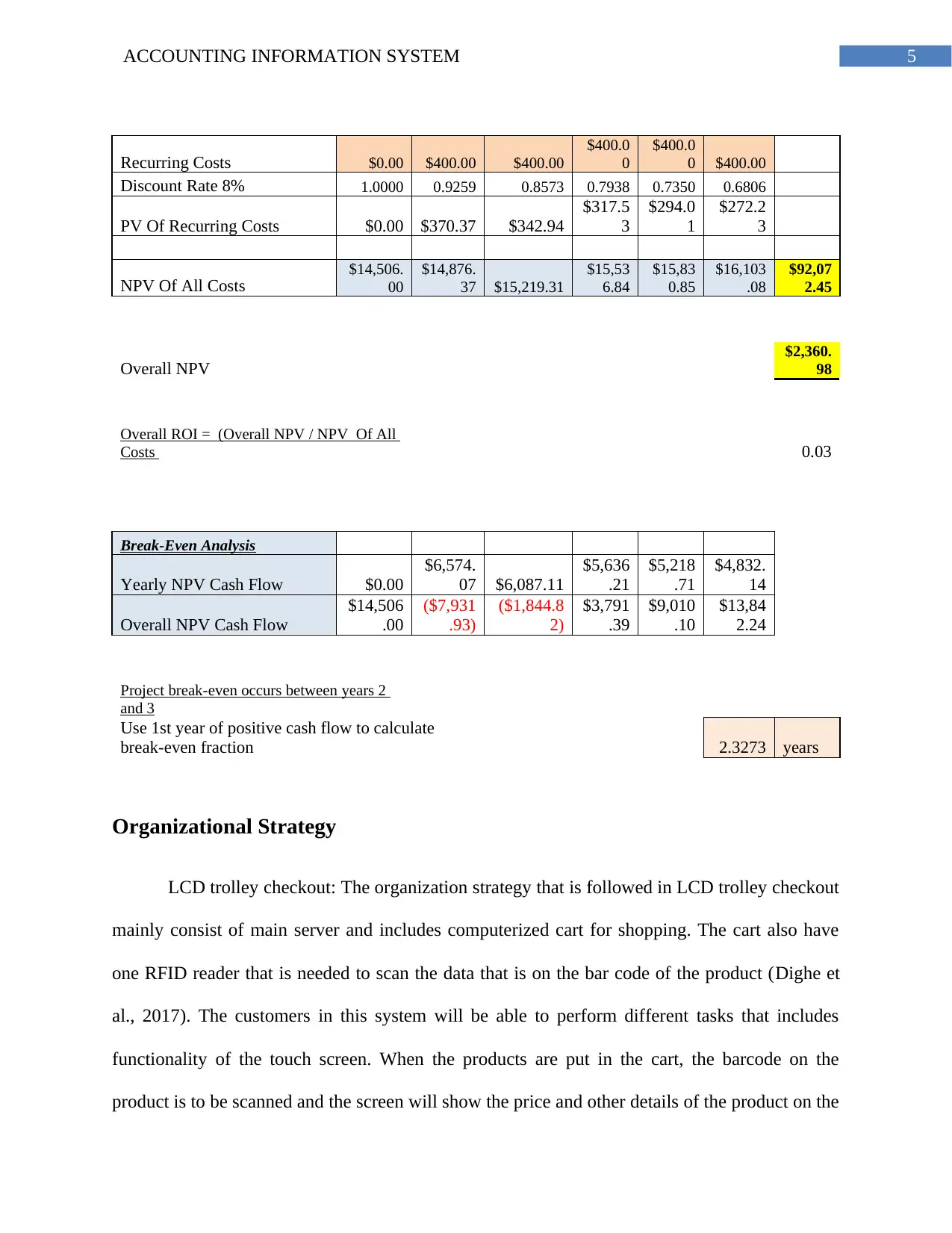
5ACCOUNTING INFORMATION SYSTEM
Recurring Costs $0.00 $400.00 $400.00
$400.0
0
$400.0
0 $400.00
Discount Rate 8% 1.0000 0.9259 0.8573 0.7938 0.7350 0.6806
PV Of Recurring Costs $0.00 $370.37 $342.94
$317.5
3
$294.0
1
$272.2
3
NPV Of All Costs
$14,506.
00
$14,876.
37 $15,219.31
$15,53
6.84
$15,83
0.85
$16,103
.08
$92,07
2.45
Overall NPV
$2,360.
98
Overall ROI = (Overall NPV / NPV Of All
Costs 0.03
Break-Even Analysis
Yearly NPV Cash Flow $0.00
$6,574.
07 $6,087.11
$5,636
.21
$5,218
.71
$4,832.
14
Overall NPV Cash Flow
$14,506
.00
($7,931
.93)
($1,844.8
2)
$3,791
.39
$9,010
.10
$13,84
2.24
Project break-even occurs between years 2
and 3
Use 1st year of positive cash flow to calculate
break-even fraction 2.3273 years
Organizational Strategy
LCD trolley checkout: The organization strategy that is followed in LCD trolley checkout
mainly consist of main server and includes computerized cart for shopping. The cart also have
one RFID reader that is needed to scan the data that is on the bar code of the product (Dighe et
al., 2017). The customers in this system will be able to perform different tasks that includes
functionality of the touch screen. When the products are put in the cart, the barcode on the
product is to be scanned and the screen will show the price and other details of the product on the
Recurring Costs $0.00 $400.00 $400.00
$400.0
0
$400.0
0 $400.00
Discount Rate 8% 1.0000 0.9259 0.8573 0.7938 0.7350 0.6806
PV Of Recurring Costs $0.00 $370.37 $342.94
$317.5
3
$294.0
1
$272.2
3
NPV Of All Costs
$14,506.
00
$14,876.
37 $15,219.31
$15,53
6.84
$15,83
0.85
$16,103
.08
$92,07
2.45
Overall NPV
$2,360.
98
Overall ROI = (Overall NPV / NPV Of All
Costs 0.03
Break-Even Analysis
Yearly NPV Cash Flow $0.00
$6,574.
07 $6,087.11
$5,636
.21
$5,218
.71
$4,832.
14
Overall NPV Cash Flow
$14,506
.00
($7,931
.93)
($1,844.8
2)
$3,791
.39
$9,010
.10
$13,84
2.24
Project break-even occurs between years 2
and 3
Use 1st year of positive cash flow to calculate
break-even fraction 2.3273 years
Organizational Strategy
LCD trolley checkout: The organization strategy that is followed in LCD trolley checkout
mainly consist of main server and includes computerized cart for shopping. The cart also have
one RFID reader that is needed to scan the data that is on the bar code of the product (Dighe et
al., 2017). The customers in this system will be able to perform different tasks that includes
functionality of the touch screen. When the products are put in the cart, the barcode on the
product is to be scanned and the screen will show the price and other details of the product on the
⊘ This is a preview!⊘
Do you want full access?
Subscribe today to unlock all pages.

Trusted by 1+ million students worldwide
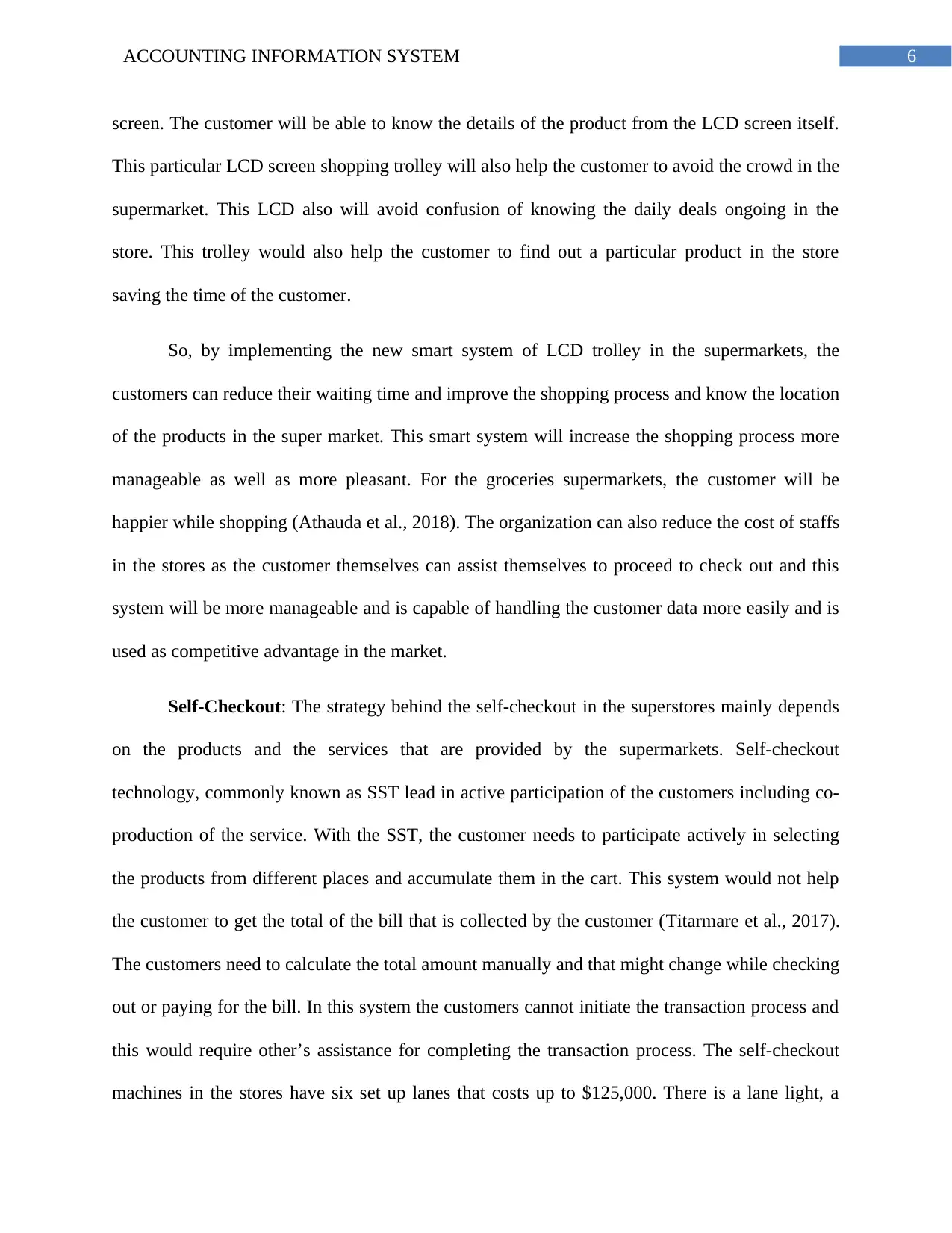
6ACCOUNTING INFORMATION SYSTEM
screen. The customer will be able to know the details of the product from the LCD screen itself.
This particular LCD screen shopping trolley will also help the customer to avoid the crowd in the
supermarket. This LCD also will avoid confusion of knowing the daily deals ongoing in the
store. This trolley would also help the customer to find out a particular product in the store
saving the time of the customer.
So, by implementing the new smart system of LCD trolley in the supermarkets, the
customers can reduce their waiting time and improve the shopping process and know the location
of the products in the super market. This smart system will increase the shopping process more
manageable as well as more pleasant. For the groceries supermarkets, the customer will be
happier while shopping (Athauda et al., 2018). The organization can also reduce the cost of staffs
in the stores as the customer themselves can assist themselves to proceed to check out and this
system will be more manageable and is capable of handling the customer data more easily and is
used as competitive advantage in the market.
Self-Checkout: The strategy behind the self-checkout in the superstores mainly depends
on the products and the services that are provided by the supermarkets. Self-checkout
technology, commonly known as SST lead in active participation of the customers including co-
production of the service. With the SST, the customer needs to participate actively in selecting
the products from different places and accumulate them in the cart. This system would not help
the customer to get the total of the bill that is collected by the customer (Titarmare et al., 2017).
The customers need to calculate the total amount manually and that might change while checking
out or paying for the bill. In this system the customers cannot initiate the transaction process and
this would require other’s assistance for completing the transaction process. The self-checkout
machines in the stores have six set up lanes that costs up to $125,000. There is a lane light, a
screen. The customer will be able to know the details of the product from the LCD screen itself.
This particular LCD screen shopping trolley will also help the customer to avoid the crowd in the
supermarket. This LCD also will avoid confusion of knowing the daily deals ongoing in the
store. This trolley would also help the customer to find out a particular product in the store
saving the time of the customer.
So, by implementing the new smart system of LCD trolley in the supermarkets, the
customers can reduce their waiting time and improve the shopping process and know the location
of the products in the super market. This smart system will increase the shopping process more
manageable as well as more pleasant. For the groceries supermarkets, the customer will be
happier while shopping (Athauda et al., 2018). The organization can also reduce the cost of staffs
in the stores as the customer themselves can assist themselves to proceed to check out and this
system will be more manageable and is capable of handling the customer data more easily and is
used as competitive advantage in the market.
Self-Checkout: The strategy behind the self-checkout in the superstores mainly depends
on the products and the services that are provided by the supermarkets. Self-checkout
technology, commonly known as SST lead in active participation of the customers including co-
production of the service. With the SST, the customer needs to participate actively in selecting
the products from different places and accumulate them in the cart. This system would not help
the customer to get the total of the bill that is collected by the customer (Titarmare et al., 2017).
The customers need to calculate the total amount manually and that might change while checking
out or paying for the bill. In this system the customers cannot initiate the transaction process and
this would require other’s assistance for completing the transaction process. The self-checkout
machines in the stores have six set up lanes that costs up to $125,000. There is a lane light, a
Paraphrase This Document
Need a fresh take? Get an instant paraphrase of this document with our AI Paraphraser
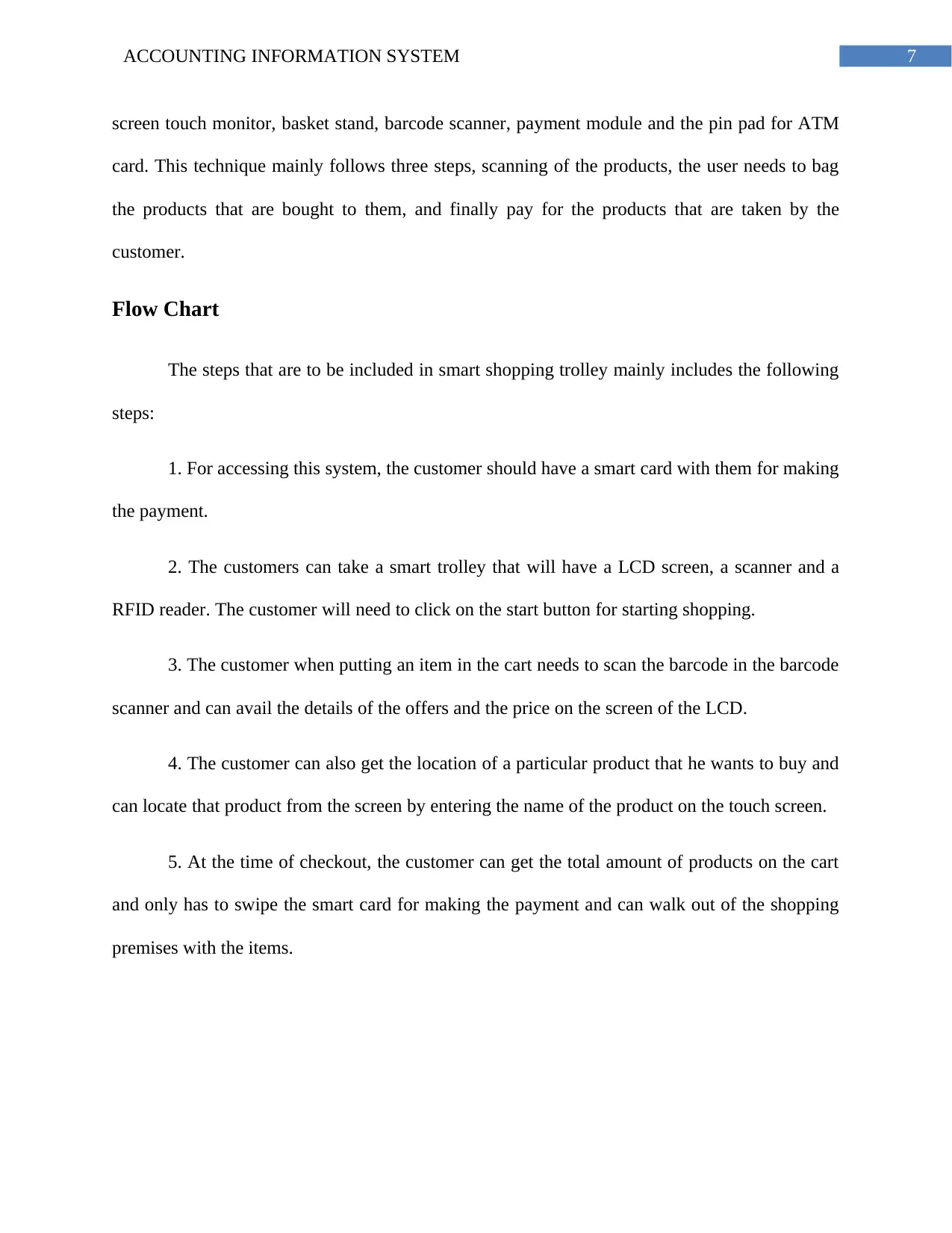
7ACCOUNTING INFORMATION SYSTEM
screen touch monitor, basket stand, barcode scanner, payment module and the pin pad for ATM
card. This technique mainly follows three steps, scanning of the products, the user needs to bag
the products that are bought to them, and finally pay for the products that are taken by the
customer.
Flow Chart
The steps that are to be included in smart shopping trolley mainly includes the following
steps:
1. For accessing this system, the customer should have a smart card with them for making
the payment.
2. The customers can take a smart trolley that will have a LCD screen, a scanner and a
RFID reader. The customer will need to click on the start button for starting shopping.
3. The customer when putting an item in the cart needs to scan the barcode in the barcode
scanner and can avail the details of the offers and the price on the screen of the LCD.
4. The customer can also get the location of a particular product that he wants to buy and
can locate that product from the screen by entering the name of the product on the touch screen.
5. At the time of checkout, the customer can get the total amount of products on the cart
and only has to swipe the smart card for making the payment and can walk out of the shopping
premises with the items.
screen touch monitor, basket stand, barcode scanner, payment module and the pin pad for ATM
card. This technique mainly follows three steps, scanning of the products, the user needs to bag
the products that are bought to them, and finally pay for the products that are taken by the
customer.
Flow Chart
The steps that are to be included in smart shopping trolley mainly includes the following
steps:
1. For accessing this system, the customer should have a smart card with them for making
the payment.
2. The customers can take a smart trolley that will have a LCD screen, a scanner and a
RFID reader. The customer will need to click on the start button for starting shopping.
3. The customer when putting an item in the cart needs to scan the barcode in the barcode
scanner and can avail the details of the offers and the price on the screen of the LCD.
4. The customer can also get the location of a particular product that he wants to buy and
can locate that product from the screen by entering the name of the product on the touch screen.
5. At the time of checkout, the customer can get the total amount of products on the cart
and only has to swipe the smart card for making the payment and can walk out of the shopping
premises with the items.
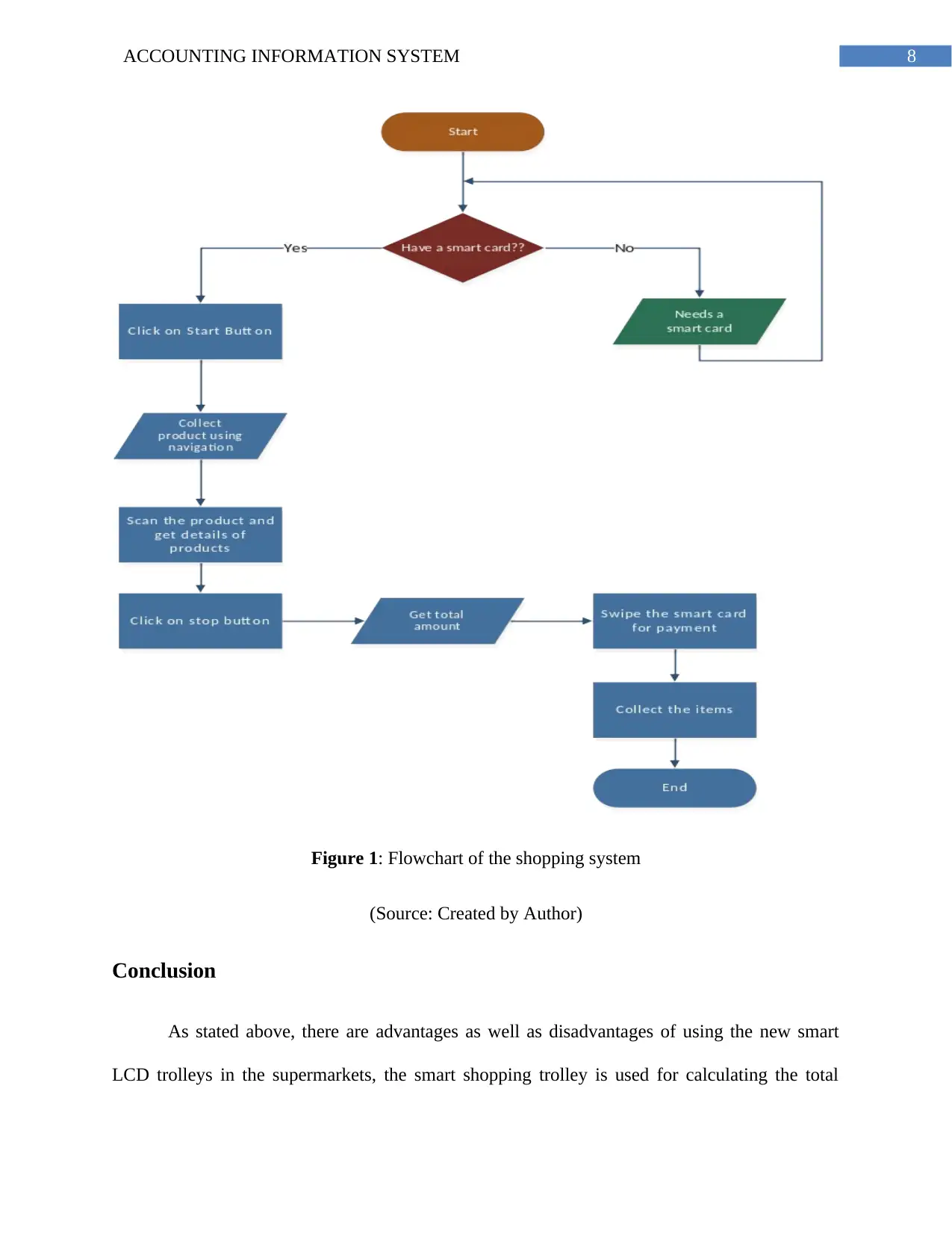
8ACCOUNTING INFORMATION SYSTEM
Figure 1: Flowchart of the shopping system
(Source: Created by Author)
Conclusion
As stated above, there are advantages as well as disadvantages of using the new smart
LCD trolleys in the supermarkets, the smart shopping trolley is used for calculating the total
Figure 1: Flowchart of the shopping system
(Source: Created by Author)
Conclusion
As stated above, there are advantages as well as disadvantages of using the new smart
LCD trolleys in the supermarkets, the smart shopping trolley is used for calculating the total
⊘ This is a preview!⊘
Do you want full access?
Subscribe today to unlock all pages.

Trusted by 1+ million students worldwide
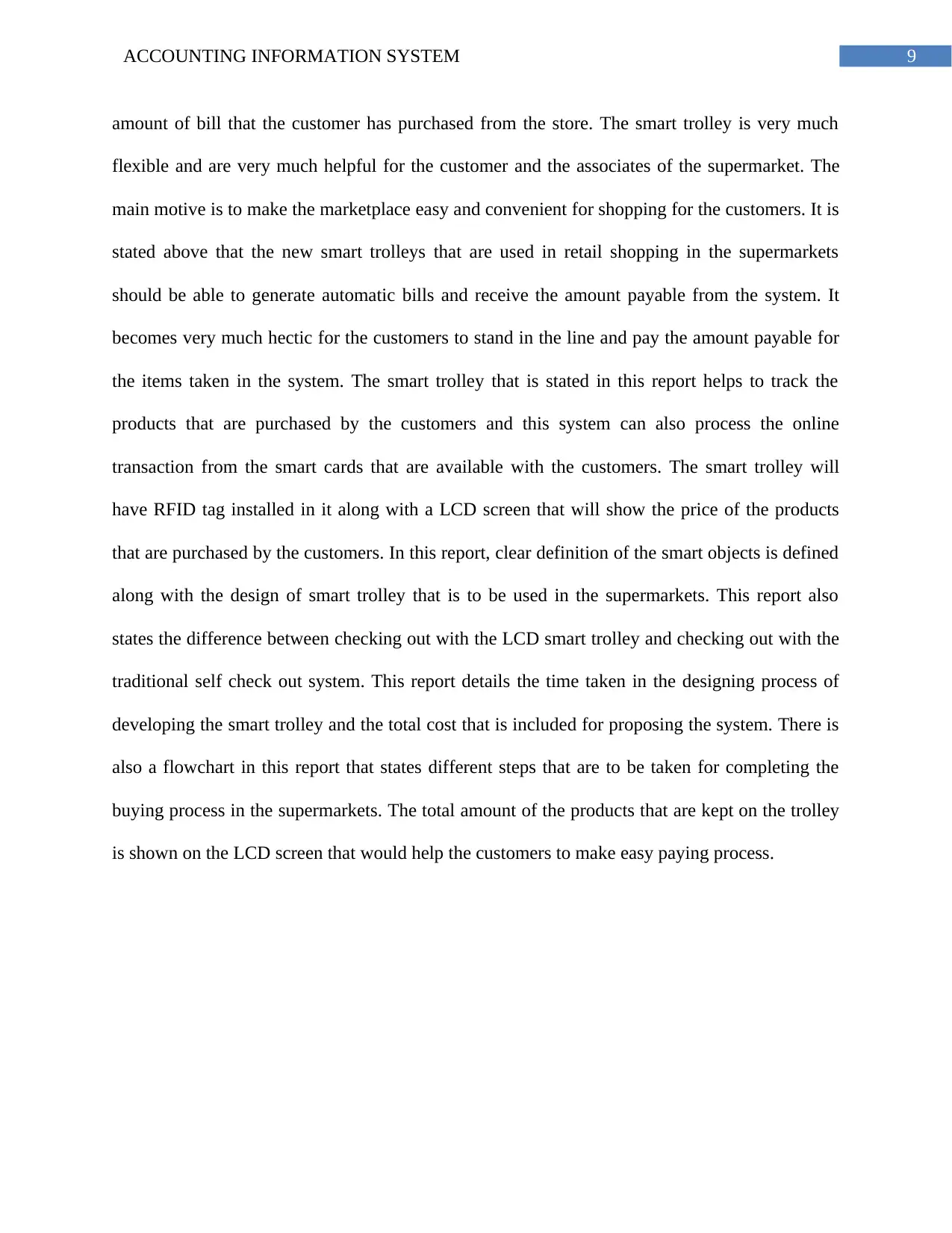
9ACCOUNTING INFORMATION SYSTEM
amount of bill that the customer has purchased from the store. The smart trolley is very much
flexible and are very much helpful for the customer and the associates of the supermarket. The
main motive is to make the marketplace easy and convenient for shopping for the customers. It is
stated above that the new smart trolleys that are used in retail shopping in the supermarkets
should be able to generate automatic bills and receive the amount payable from the system. It
becomes very much hectic for the customers to stand in the line and pay the amount payable for
the items taken in the system. The smart trolley that is stated in this report helps to track the
products that are purchased by the customers and this system can also process the online
transaction from the smart cards that are available with the customers. The smart trolley will
have RFID tag installed in it along with a LCD screen that will show the price of the products
that are purchased by the customers. In this report, clear definition of the smart objects is defined
along with the design of smart trolley that is to be used in the supermarkets. This report also
states the difference between checking out with the LCD smart trolley and checking out with the
traditional self check out system. This report details the time taken in the designing process of
developing the smart trolley and the total cost that is included for proposing the system. There is
also a flowchart in this report that states different steps that are to be taken for completing the
buying process in the supermarkets. The total amount of the products that are kept on the trolley
is shown on the LCD screen that would help the customers to make easy paying process.
amount of bill that the customer has purchased from the store. The smart trolley is very much
flexible and are very much helpful for the customer and the associates of the supermarket. The
main motive is to make the marketplace easy and convenient for shopping for the customers. It is
stated above that the new smart trolleys that are used in retail shopping in the supermarkets
should be able to generate automatic bills and receive the amount payable from the system. It
becomes very much hectic for the customers to stand in the line and pay the amount payable for
the items taken in the system. The smart trolley that is stated in this report helps to track the
products that are purchased by the customers and this system can also process the online
transaction from the smart cards that are available with the customers. The smart trolley will
have RFID tag installed in it along with a LCD screen that will show the price of the products
that are purchased by the customers. In this report, clear definition of the smart objects is defined
along with the design of smart trolley that is to be used in the supermarkets. This report also
states the difference between checking out with the LCD smart trolley and checking out with the
traditional self check out system. This report details the time taken in the designing process of
developing the smart trolley and the total cost that is included for proposing the system. There is
also a flowchart in this report that states different steps that are to be taken for completing the
buying process in the supermarkets. The total amount of the products that are kept on the trolley
is shown on the LCD screen that would help the customers to make easy paying process.
Paraphrase This Document
Need a fresh take? Get an instant paraphrase of this document with our AI Paraphraser
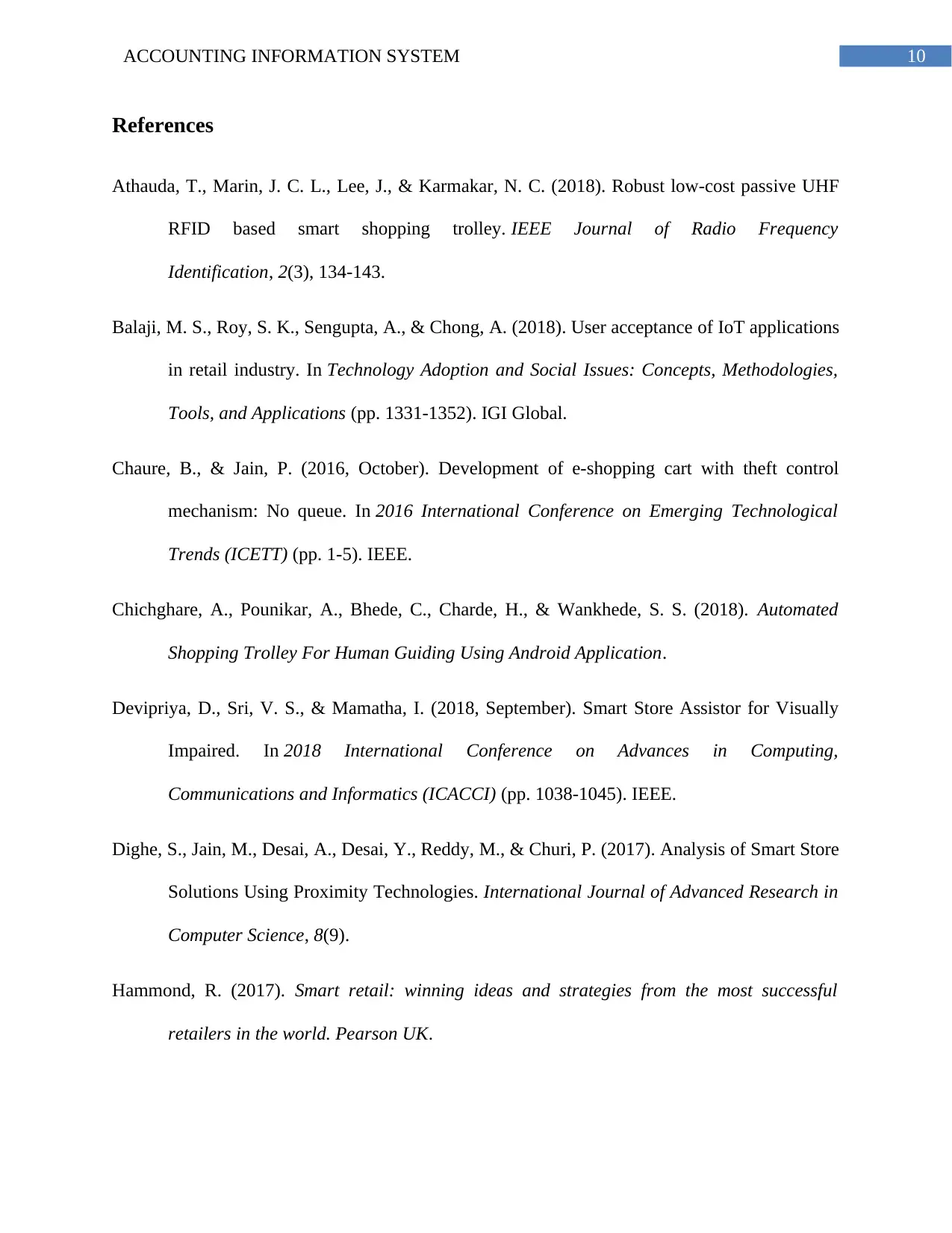
10ACCOUNTING INFORMATION SYSTEM
References
Athauda, T., Marin, J. C. L., Lee, J., & Karmakar, N. C. (2018). Robust low-cost passive UHF
RFID based smart shopping trolley. IEEE Journal of Radio Frequency
Identification, 2(3), 134-143.
Balaji, M. S., Roy, S. K., Sengupta, A., & Chong, A. (2018). User acceptance of IoT applications
in retail industry. In Technology Adoption and Social Issues: Concepts, Methodologies,
Tools, and Applications (pp. 1331-1352). IGI Global.
Chaure, B., & Jain, P. (2016, October). Development of e-shopping cart with theft control
mechanism: No queue. In 2016 International Conference on Emerging Technological
Trends (ICETT) (pp. 1-5). IEEE.
Chichghare, A., Pounikar, A., Bhede, C., Charde, H., & Wankhede, S. S. (2018). Automated
Shopping Trolley For Human Guiding Using Android Application.
Devipriya, D., Sri, V. S., & Mamatha, I. (2018, September). Smart Store Assistor for Visually
Impaired. In 2018 International Conference on Advances in Computing,
Communications and Informatics (ICACCI) (pp. 1038-1045). IEEE.
Dighe, S., Jain, M., Desai, A., Desai, Y., Reddy, M., & Churi, P. (2017). Analysis of Smart Store
Solutions Using Proximity Technologies. International Journal of Advanced Research in
Computer Science, 8(9).
Hammond, R. (2017). Smart retail: winning ideas and strategies from the most successful
retailers in the world. Pearson UK.
References
Athauda, T., Marin, J. C. L., Lee, J., & Karmakar, N. C. (2018). Robust low-cost passive UHF
RFID based smart shopping trolley. IEEE Journal of Radio Frequency
Identification, 2(3), 134-143.
Balaji, M. S., Roy, S. K., Sengupta, A., & Chong, A. (2018). User acceptance of IoT applications
in retail industry. In Technology Adoption and Social Issues: Concepts, Methodologies,
Tools, and Applications (pp. 1331-1352). IGI Global.
Chaure, B., & Jain, P. (2016, October). Development of e-shopping cart with theft control
mechanism: No queue. In 2016 International Conference on Emerging Technological
Trends (ICETT) (pp. 1-5). IEEE.
Chichghare, A., Pounikar, A., Bhede, C., Charde, H., & Wankhede, S. S. (2018). Automated
Shopping Trolley For Human Guiding Using Android Application.
Devipriya, D., Sri, V. S., & Mamatha, I. (2018, September). Smart Store Assistor for Visually
Impaired. In 2018 International Conference on Advances in Computing,
Communications and Informatics (ICACCI) (pp. 1038-1045). IEEE.
Dighe, S., Jain, M., Desai, A., Desai, Y., Reddy, M., & Churi, P. (2017). Analysis of Smart Store
Solutions Using Proximity Technologies. International Journal of Advanced Research in
Computer Science, 8(9).
Hammond, R. (2017). Smart retail: winning ideas and strategies from the most successful
retailers in the world. Pearson UK.
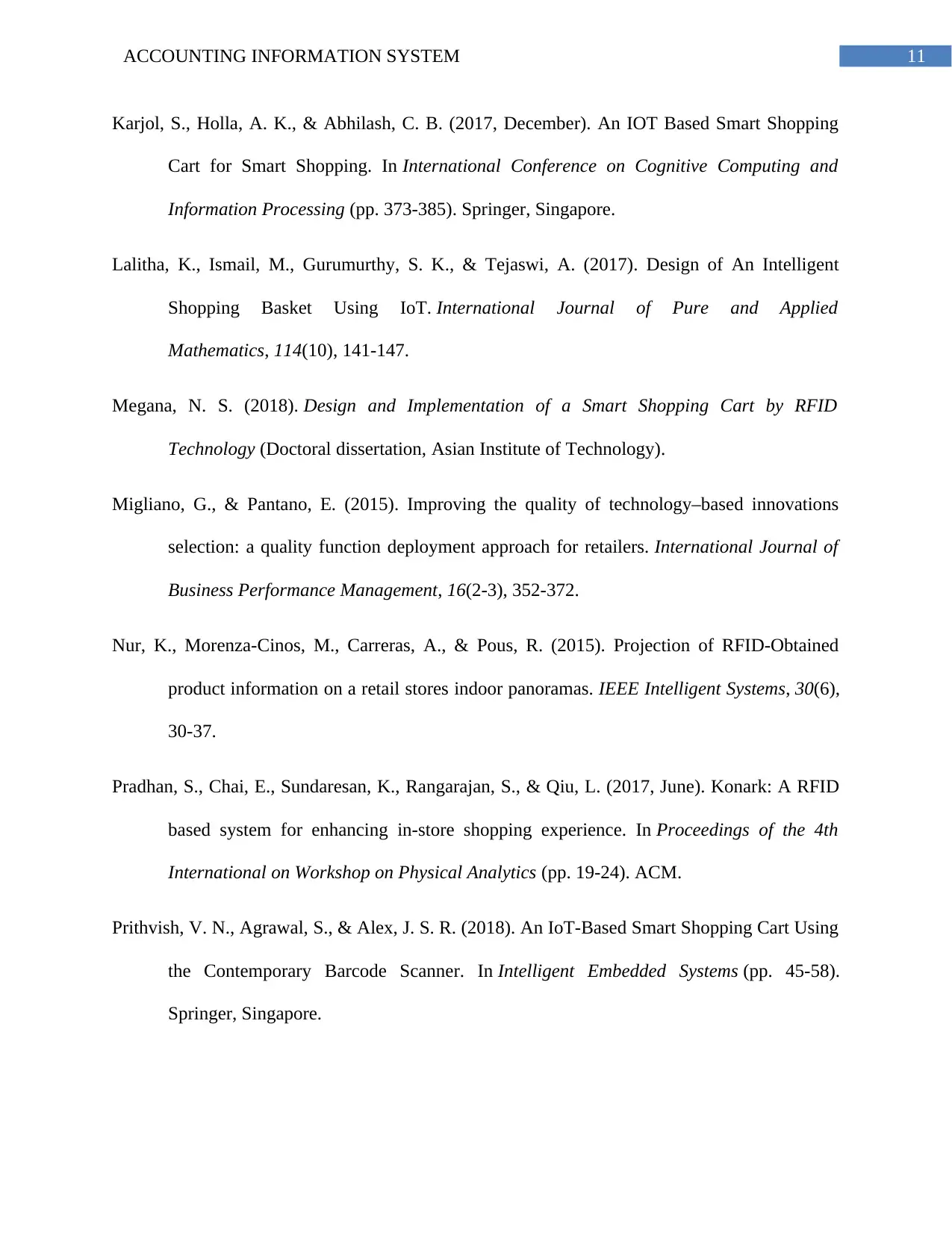
11ACCOUNTING INFORMATION SYSTEM
Karjol, S., Holla, A. K., & Abhilash, C. B. (2017, December). An IOT Based Smart Shopping
Cart for Smart Shopping. In International Conference on Cognitive Computing and
Information Processing (pp. 373-385). Springer, Singapore.
Lalitha, K., Ismail, M., Gurumurthy, S. K., & Tejaswi, A. (2017). Design of An Intelligent
Shopping Basket Using IoT. International Journal of Pure and Applied
Mathematics, 114(10), 141-147.
Megana, N. S. (2018). Design and Implementation of a Smart Shopping Cart by RFID
Technology (Doctoral dissertation, Asian Institute of Technology).
Migliano, G., & Pantano, E. (2015). Improving the quality of technology–based innovations
selection: a quality function deployment approach for retailers. International Journal of
Business Performance Management, 16(2-3), 352-372.
Nur, K., Morenza-Cinos, M., Carreras, A., & Pous, R. (2015). Projection of RFID-Obtained
product information on a retail stores indoor panoramas. IEEE Intelligent Systems, 30(6),
30-37.
Pradhan, S., Chai, E., Sundaresan, K., Rangarajan, S., & Qiu, L. (2017, June). Konark: A RFID
based system for enhancing in-store shopping experience. In Proceedings of the 4th
International on Workshop on Physical Analytics (pp. 19-24). ACM.
Prithvish, V. N., Agrawal, S., & Alex, J. S. R. (2018). An IoT-Based Smart Shopping Cart Using
the Contemporary Barcode Scanner. In Intelligent Embedded Systems (pp. 45-58).
Springer, Singapore.
Karjol, S., Holla, A. K., & Abhilash, C. B. (2017, December). An IOT Based Smart Shopping
Cart for Smart Shopping. In International Conference on Cognitive Computing and
Information Processing (pp. 373-385). Springer, Singapore.
Lalitha, K., Ismail, M., Gurumurthy, S. K., & Tejaswi, A. (2017). Design of An Intelligent
Shopping Basket Using IoT. International Journal of Pure and Applied
Mathematics, 114(10), 141-147.
Megana, N. S. (2018). Design and Implementation of a Smart Shopping Cart by RFID
Technology (Doctoral dissertation, Asian Institute of Technology).
Migliano, G., & Pantano, E. (2015). Improving the quality of technology–based innovations
selection: a quality function deployment approach for retailers. International Journal of
Business Performance Management, 16(2-3), 352-372.
Nur, K., Morenza-Cinos, M., Carreras, A., & Pous, R. (2015). Projection of RFID-Obtained
product information on a retail stores indoor panoramas. IEEE Intelligent Systems, 30(6),
30-37.
Pradhan, S., Chai, E., Sundaresan, K., Rangarajan, S., & Qiu, L. (2017, June). Konark: A RFID
based system for enhancing in-store shopping experience. In Proceedings of the 4th
International on Workshop on Physical Analytics (pp. 19-24). ACM.
Prithvish, V. N., Agrawal, S., & Alex, J. S. R. (2018). An IoT-Based Smart Shopping Cart Using
the Contemporary Barcode Scanner. In Intelligent Embedded Systems (pp. 45-58).
Springer, Singapore.
⊘ This is a preview!⊘
Do you want full access?
Subscribe today to unlock all pages.

Trusted by 1+ million students worldwide
1 out of 13
Related Documents
Your All-in-One AI-Powered Toolkit for Academic Success.
+13062052269
info@desklib.com
Available 24*7 on WhatsApp / Email
![[object Object]](/_next/static/media/star-bottom.7253800d.svg)
Unlock your academic potential
Copyright © 2020–2025 A2Z Services. All Rights Reserved. Developed and managed by ZUCOL.





